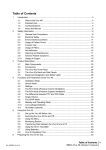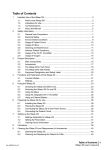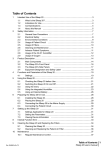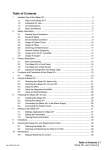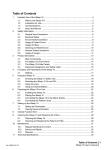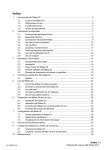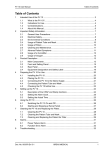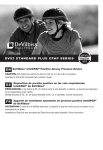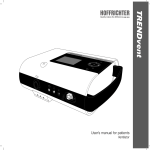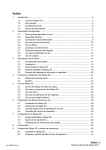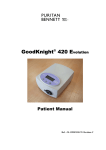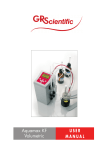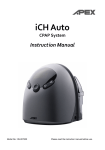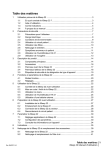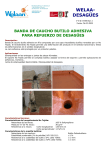Download 7 Setting Up the Vivo 30
Transcript
Table of Contents 1 Introduction ..................................................................................................................... 3 2 1.1 What is the Vivo 30? ......................................................................................... 4 1.2 Intended Use..................................................................................................... 4 1.3 Contraindications .............................................................................................. 5 1.4 About this Manual .......................................................................................... 6 Safety Information........................................................................................................... 8 3 2.1 General User Precautions ............................................................................... 8 2.2 Electrical Safety ............................................................................................ 10 2.3 Environmental Conditions ............................................................................. 11 2.4 Usage of Patient Circuit ............................................................................... 12 2.5 Usage of Filters ............................................................................................... 13 2.6 Humidification ............................................................................................... 14 2.7 Cleaning and Maintenance ............................................................................. 14 2.8 Adverse Patient Symptoms............................................................................. 15 2.9 Usage of Oxygen .......................................................................................... 16 Product Description....................................................................................................... 18 4 3.1 Main Components ........................................................................................... 18 3.2 Accessories ........................................................................................ 20 3.3 The Vivo 30’s Front Panel .......................................................................... 22 3.4 The Vivo 30's Back and Side Panels ........................................................... 23 3.5 Equipment Designation and Safety Label .................................................. 24 Functions and Parameters of the Vivo 30 ..................................................................... 25 5 4.1 Ventilation Mode.............................................................................................. 25 4.2 Device Mode ................................................................................................... 25 4.3 Settings ........................................................................................................... 25 4.4 The PCV Mode (Pressure Control Ventilation)................................................ 28 4.5 The PSV Mode (Pressure Support Ventilation)............................................... 29 4.6 The Difference between PCV and PSV Mode ................................................ 30 4.7 The CPAP Mode ............................................................................................. 30 4.8 Standby and Operating Mode ......................................................................... 31 4.9 Low Leakage Detection................................................................................... 31 4.10 Humidifier (optional) ........................................................................................ 31 Using the Vivo 30 .......................................................................................................... 32 6 5.1 Set up the Vivo 30 Before Use........................................................................ 32 5.2 Switching the Vivo 30 On and Off ................................................................... 33 5.3 Using the Menu ............................................................................................... 34 5.4 Monitoring Section .......................................................................................... 40 5.5 Transferring Data between the Vivo 30 and a PC ......................................... 41 5.6 Using the HA 01 Humidifier ....................................................................... 45 5.7 Using Batteries................................................................................................ 45 5.8 Vivo 30 Operating Time................................................................................... 47 Preparing the Vivo 30 for Use ....................................................................................... 48 6.1 6.2 Doc. 003887 En-Us A-1e Installing the Vivo 30 ....................................................................................... 48 Placing the Vivo 30 ....................................................................................... 49 Table of Contents 1 BREAS Vivo 30 clinician’s manual 7 6.3 Connecting the Vivo 30 to the AC Power Source .......................................... 49 6.4 Connecting the Patient Circuit......................................................................... 50 Setting Up the Vivo 30 ................................................................................................ 51 8 7.1 7.2 7.3 Alarms 9 8.1 Alarm Function ................................................................................................ 58 8.2 Physiological Alarm......................................................................................... 61 8.3 Technical Alarm............................................................................................... 66 Complete Function Check............................................................................................. 69 10 9.1 Pre-use Check ................................................................................................ 69 9.2 Alarm Check ................................................................................................... 70 Cleaning the Vivo 30 and Replacement of Accessories ............................................... 72 11 10.1 Cleaning the Vivo 30 ...................................................................................... 72 10.2 Cleaning and Replacing the Patient Air Filters................................................ 74 10.3 Change of Patient ........................................................................................... 75 Maintenance ................................................................................................................. 76 12 11.1 Regular Maintenance Control ......................................................................... 76 11.2 Service and Repair.......................................................................................... 77 11.3 Storage............................................................................................................ 77 11.4 Disposal .......................................................................................................... 77 Technical Specifications ................................................................................................ 78 13 12.1 System Description ...................................................................................... 78 12.2 Data ................................................................................................. 79 12.3 Compliance of Standards ............................................................................. 83 12.4 Delivery Settings ...................................................................................... 85 Accessories................................................................................................................... 87 13.1 Settings Applicable for the Different Modes ................................................... 52 Selecting the Mode ......................................................................................... 53 Setting the Parameters ................................................................................. 54 .......................................................................................................................... 58 Breas Accessories List.................................................................................... 87 2 Table of Contents BREAS Vivo 30 clinician’s manual Doc. 003887 En-Us A-1e 1 Introduction WARNING! Vivo 30 must only be used: • For the intended treatment in accordance with this operating manual and with the instructions given by the responsible clinical personnel. • In accordance with the operating conditions specified in this operating manual. • In original and unmodified shape and only with accessories specified or approved by Breas Medical AB. Every other use may lead to risk of personal injury! CAUTION! Read this operating manual thoroughly so that you completely understand how the Vivo 30 is operated and maintained before taking it into use, to ensure correct usage, maximum performance and serviceability. WARNING! Do not use the Vivo 30 for any kind of life support treatment. Breas Medical AB reserves the right to make changes to this product without any prior notification. Doc. 003887 En-Us A-1e Introduction 3 Vivo 30 clinician’s manual 1.1 What is the Vivo 30? The Vivo 30 is a pressure-supported and pressure-controlled ventilator. It has three modes of operation: PCV (Pressure Control Ventilation), PSV (Pressure Support Ventilation) and CPAP (Continuous Positive Airway Pressure). The PCV and PSV modes have an adjustable inspiratory trigger sensitivity setting which allows the patient to initiate ventilator-assisted breaths. • In the PCV mode (Pressure Control Ventilation), the ventilator provides assisted or controlled pressure-regulated breathing. In PCV mode, the clinician sets an inspiration time. The inspiratory pressure is set by the IPAP (Inspiratory Positive Airway Pressure) setting. The end-expiratory pressure is set by the EPAP (Expiratory Positive Airway Pressure) setting. • In the PSV mode (Pressure Support Ventilation), the ventilator’s expiratory trigger can also be adjusted allowing the ventilator to more easily match each patient’s needs. The inspiratory pressure is set by the IPAP setting. The end-expiratory pressure is set by the EPAP setting. • In the CPAP mode (Continuous Positive Airway Pressure), the ventilator provides a continuous positive airway pressure. The Vivo 30 has a pressure sensor that continuously monitors output pressure to the patient and reference ambient pressure, so that the device automatically will compensate for altitude changes. The internal memory of the Vivo 30 can be downloaded to a PC where you can view the patient compliance data in the Breas Vivo PC Software. For more information about the Breas Vivo PC Software, please contact your Breas representative. 1.2 Intended Use The Vivo 30 is not intended for life support or life-sustaining applications or for transport of critical care patients. The Vivo 30 shall only be used by patients with spontaneous breathing. The Vivo 30 is designed for patients who require long-term support by mechanical ventilation during night and part of the day, up to a maximum of 20 hours of use per day. The Vivo 30 is intended for non-invasive use. 4 Introduction Vivo 30 clinician’s manual Doc. 003887 En-Us A-1e The Vivo 30 is intended for use in clinical settings (e.g., hospitals, sleep laboratories, sub-acute care institutions) and home environments. The Vivo 30 must always be prescribed by a licensed physician. The Vivo 30 is intended for treatment of adult patients only. The Vivo 30 is intended to be operated by qualified and trained personnel, or by personnel who have been taught using the clinician’s manual. The CPAP function is intended to deliver continuous positive airway pressure therapy for the treatment of obstructive sleep apnea, via non-invasive nasal or full-face masks. 1.3 Contraindications The use of the Vivo 30 is contraindicated on patients with severe respiratory failure without a spontaneous respiratory drive. The use of the Vivo 30 for positive pressure therapy may be contraindicated on patients: • Incapable of maintaining life- sustaining ventilation in the event of a brief circuit disconnection or loss of therapy. • Unable to maintain a patent airway or adequately clear secretions. • At risk for aspiration of gastric contents. • With a history of allergy or hypersensitivity to the mask materials where the risk from allergic reaction outweighs the benefit of ventilatory assistance. Therapy with the Vivo 30 should not be prescribed when the following specific diseases or conditions are present: • Bullous lung disease • Pathologically low blood pressure • Severe cardiac arrhythmias • Coronary artery disease • Unstable angina pectoris • Decompensated cardiac failure or hypotension, particularly if associated with intravascular volume depletion • Recent thoracic surgery • Pneumothorax Doc. 003887 En-Us A-1e Introduction 5 Vivo 30 clinician’s manual • Pneumomediastinum • Massive epistaxis or previous history of massive epistaxis (risk of recurrence) • Pneumoencephalus, recent trauma or surgery that may have produced cranio-nasopharyngeal fistula • Cerebral spinal fluid (CSF) leaks • Acute or unstable respiratory failure or insufficiency Caution should be used when prescribing positive airway pressure therapy for susceptible patients, such as patients with abnormalities of the cribriform plate, or prior history of head trauma. The use of CPAP therapy may be temporarily contraindicated if the patient exhibits signs of a sinus or middle ear infection. 1.4 About this Manual Always read this manual before setting up and using the Vivo 30 or performing maintenance on the machine, to ensure correct usage, maximum performance and serviceability. Breas Medical AB reserves the right to make changes to the contents of this manual without any prior notification. Audience This manual is primarily intended for care providers, clinical personnel, physicians and others who require a working knowledge of the Breas Vivo 30 system. The manual comprises detailed information on the settings and functions of the Vivo 30 to be handled by trained health care personnel only. • Patients and other lay users operating the Vivo 30 will find all the information they need in the User Manual. • Service personnel may order the Vivo 30 Service Manual that contains detailed technical information for maintenance, service and repair. 6 Introduction Vivo 30 clinician’s manual Doc. 003887 En-Us A-1e Icons In this manual, icons are used to highlight specific information. The meaning of each icon is explained in the table below. ICON EXPLANATION Warning! Risk of death and serious personal injury. Caution! Risk of minor or moderate injury. Risk of equipment damage, loss of data, extra work, or unexpected results. Note Information that may be valuable but is not of critical importance, tips. Reference Reference to other manuals with additional information on a specific topic. Doc. 003887 En-Us A-1e Introduction 7 Vivo 30 clinician’s manual 2 Safety Information 2.1 General User Precautions • U.S. Federal law restricts this device for sale by or on order of a physician. • The Vivo 30 should not be used for any kind of life support treatment. • The Vivo 30 shall only be used by patients with spontaneous breathing. • Advice contained in this manual should not supersede instructions given by the prescribing physician. • If the patient is admitted to a hospital or is prescribed any other form of medical treatment, always inform the medical staff that the patient is on mechanical ventilation treatment. • Vivo 30 must only be used: – for the intended treatment in accordance with this operating manual and with the instructions given by the responsible clinical personnel; – in accordance with the operating conditions specified in this operating manual; – in original and unmodified shape and only with accessories specified or approved by Breas Medical AB. • Do not use the Vivo 30 in the event of suspected damage to the device, unexplainable or sudden pressure, performance or sound changes during operation, or if the delivered air from the Vivo 30 is abnormally hot or emits an odor. Contact your responsible care provider for an inspection. • Inadequate use of device or accessories may cause loss of treatment or decreased performance. • The Vivo 30 therapy settings must always be based on medical supervision and must be changed by authorized clinical personnel only. Blood gas measurement should be performed when changing settings or changing to another device. • Always perform the procedure “Set up the Vivo 30 Before Use” on page 32 before using the Vivo 30. • Only use accessories recommended by Breas Medical AB. 8 Safety Information Vivo 30 clinician’s manual Doc. 003887 En-Us A-1e • Clinical personnel must read the Clinician’s manual thoroughly and understand the Vivo 30 operation before setting up and using the machine. • The user must read the user manual thoroughly and understand the Vivo 30 operation before using the machine. • All the physiological alarms of the Vivo 30 must be set at safe levels that will effectively warn the user of any risk. The alarm levels should be assessed considering the patient settings. Any change of settings or components may require the readjustment of the alarm levels. • Handle the Vivo 30 with care. • Do not use the Vivo 30 while in a carry bag. Attach the rear lid and place the swivel in a down position when placing the Vivo 30 in the bag. • If using the Vivo 30 for a short intra hospital or vehicle transportation, the following cautions need to be observed: – Do not mount the Vivo 30 on a wheelchair or in a vehicle. – Make sure that the Vivo 30 stands securely in a upright position and cannot tilt or fall. – Do not use the Vivo 30 outdoors during rain or snowfall. – If the HA 01 humidifier is attached, make sure that it is not in use and that it is empty. Doc. 003887 En-Us A-1e Safety Information 9 Vivo 30 clinician’s manual 2.2 Electrical Safety • Do not operate the Vivo 30 if it has a damaged power cord or casing. • The Vivo 30 may not work properly if any part has been dropped, damaged or submerged in water. • To avoid electrical shock, disconnect the electrical supply to the Vivo 30 before cleaning. Do not immerse the Vivo 30 into any fluids. • The operator shall not touch accessible contacts of connectors and the patient simultaneously. • When handling the HA 01 humidifier, always turn off the Vivo 30 and disconnect the Vivo 30 from the AC power supply. • Accessory equipment connected to the analog and digital interfaces must be certified according to the respective IEC standards (e.g. IEC 60950 for data processing equipment and IEC 60601-1 for medical equipment). Furthermore, all configurations shall comply with the valid version of the system standard IEC 60601-1-1. Therefore, everyone who connects additional equipment to the signal input part or signal output part configures a medical system is responsible that the system complies with the requirements of the valid version of the system standard IEC 60601-1-1. If in doubt, consult the technical service department or your local representative. • If an external battery is used, always disconnect it when the Vivo 30 is switched off. Otherwise there is a risk that the battery will discharge. • If the AC power source fails and an external battery activates, the HA 20 humidifier will be turned off automatically. It must be activated again manually, if humidification during battery use is necessary. • Only use the data connection to connect the Vivo 30 to the iCom or a PC. 10 Safety Information Vivo 30 clinician’s manual Doc. 003887 En-Us A-1e 2.3 Environmental Conditions • Do not use the Vivo 30 in any toxic environment. • Do not use the Vivo 30 in environments where there are explosive gases or other flammable anesthetic agents present. • The air flow for breathing produced by the Vivo 30 can be as much as 10°F (5°C) higher than room temperature. Caution should be exercised if the room temperature is greater that 95°F (35°C). • If a room humidifier is used, place it at least 6 feet (2 meters) away from the Vivo 30. • The performance of the Vivo 30 may deteriorate at ambient temperatures below 41°F (5°C) and above 100°F (38°C). • Do not use the Vivo 30 while positioned in a warm place, such as direct sunlight. • The device complies with the EMC requirements of standards listed in “Compliance of Standards” on page 83. Necessary measures should be taken in order to assure that field levels exceeding 10 V/m are avoided, since this may impair the safety and performance of the Vivo 30. Measures should include but not be limited to: – normal precautions with regard to relative humidity and conductive characteristics of clothing in order to minimize the build-up of electrostatic charges. – avoiding the use of radio emitting devices closer than 1 m to the Vivo 30. Examples include: radio emitting devices such as cellular or cordless telephones, microwave ovens and high-frequency surgery apparatus. • The Vivo 30, all accessories and replacement parts must be disposed of in accordance with the local environmental regulations regarding the disposal of used equipment and waste. • The performance of the Vivo 30 and treatment of the patient may deteriorate if the operation conditions in “Technical Specifications” on page 78 are not fulfilled. Do not use the Vivo 30 immediately after storage or transport outside the recommended operating conditions. Doc. 003887 En-Us A-1e Safety Information 11 Vivo 30 clinician’s manual 2.4 Usage of Patient Circuit • Only use the Vivo 30 with a mask, patient tube and leakage port recommended by Breas Medical AB and your health care professional. • The Vivo 30 requires an intentional leak port instead of an actively controlled exhalation valve to remove exhaled gases from the patient circuit. Therefore, specific masks and patient circuits using an intentional leakage are required for normal operation. The pressurized air from the Vivo 30 causes a continuous flow of air to exhaust from the leak ports, flushing exhaled gas from the circuit. The Vivo 30 should be turned on and the intentional leak ports should be checked before application. • Do not breathe in the connected patient circuit unless the Vivo 30 is turned on and operating properly. • Do not use patient hoses or tubes made of static or electrically conductive material. • Always use a new mask, tube and leakage port when the Vivo 30 is to be used by a new patient. • Patient connected parts and filter must be replaced regularly to ensure correct function of the Vivo 30. All replaced parts must be disposed of according to local environmental regulations regarding the disposal of used equipment and parts. • Periodically check for moisture in the patient circuit. When present, remove the moisture. Before attempting to dry the circuit, disconnect it from the Vivo 30 to ensure no water will flow back into the Vivo 30. The frequency at which these checks must be performed will depend on the patient’s own condition and the device used. You should assess this on an individual basis in accordance with the patient’s needs. • If the patient is using a full face mask (covering mouth and nose), the mask must be equipped with a safety entrainment valve. 12 Safety Information Vivo 30 clinician’s manual Doc. 003887 En-Us A-1e • Make sure that the ventilation holes in the mask or the leakage ports are never blocked or obstructed. These ports are used to prevent re-breathing of exhaled air. Re-breathing of exhaled gases for longer than several minutes can, in some circumstances, lead to suffocation. • At low CPAP pressures, the air flow through the ventilation holes in the mask or the leakage ports may be inadequate to clear all exhaled gases. Some re-breathing may occur. • Do not leave long lengths of air tubing around the top of the bed. It could twist around the patient’s head or neck while sleeping. • Always follow the instructions of the mask manufacturer. 2.5 Usage of Filters • Always use the Vivo 30 with patient air inlet filters installed. Only use filters that are specified in this manual. • Replace or clean the filters regularly to ensure correct function of the Vivo 30, especially when changing patient. Failure to replace or clean a dirty filter may cause the Vivo 30 to operate at higher temperatures than intended. • When operating the Vivo 30, make sure that the air inlet and filters are not obstructed or occluded. • If the Vivo 30 is used in a clinic by several patients, a low resistance bacteria filter is recommended between the air outlet and the patient circuit to prevent patient cross-contamination. Breas Medical AB recommends the usage of the Breas filter 004185, see “Breas Accessories List” on page 87. Reuse of mask or bacteria filter may expose patients to contagious agents. • The use of a high resistance bacteria filter on the output of the device may interfere with the operation of the patient disconnect function. It may also interfere with the device trigger function. • Do not connect any filter to the HA 01 humidifier. Doc. 003887 En-Us A-1e Safety Information 13 Vivo 30 clinician’s manual 2.6 Humidification • The HA 01 humidifier is intended for non-invasive use only. • Do not place the Vivo 30 with the HA 01 humidifier in a bag. • When the HA 01 humidifier is installed, the Vivo 30 must be located below the patient and on a flat surface. This is to prevent personal injury from accidental spillage or from excess water or condensation flowing down the patient tube and into the patient’s mask. Extra cautions should be taken for patients who are unable to guard their airways or cannot pull off the mask. • When using an external heated humidifier, it should be located below the Vivo 30 and the patient to prevent injury from accidental spillage. • If the condensation in the patient circuit is excessive, the use of a heated humidifier may require the installation of a water trap in the circuit. The water trap prevents any condensated water in the patient circuit from running into the patient airways and causing personal injury. The use of an HME (Heat and Moisture Exchanger, artificial nose) or an external humidifier may require readjustment of the Vivo 30’s low-pressure alarm. 2.7 Cleaning and Maintenance • The Vivo 30 should be cleaned and maintained in accordance with this operating manual. • Do not attempt to autoclave or sterilize the Vivo 30. • Vivo 30 should be subjected to maintenance, service and control and any applicable upgrades, in accordance with Breas service instructions. • Vivo 30 shall only be repaired or modified in accordance with Breas service manuals, technical bulletins, and any special service instructions, by service technicians authorized by Breas Medical AB. • Do not under any circumstances attempt to service or repair the Vivo 30 yourself. If you do so, the manufacturer will no longer be responsible for the performance and safety of the Vivo 30. Furthermore, no warranty will be valid. 14 Safety Information Vivo 30 clinician’s manual Doc. 003887 En-Us A-1e 2.8 Adverse Patient Symptoms If the patient experiences discomfort or any of the following symptoms while using the Vivo 30, a physician or responsible clinician shall be contacted immediately: • Bloated feeling from excessive swallowing of air while awake • Air continually leaking from the mouth while sleeping • Dryness of air passages or nose • Ear pain, runny nose or sinus discomfort • Day time sleepiness • Disorientation or memory lapse • Mood change or irritability • Skin sensitivity • Severe headache • Chest discomfort • Shortness of breath The following are potential side effects of non-invasive positive pressure therapy: • Ear discomfort • Conjunctivitis • Skin abrasions due to non-invasive interfaces • Aero phagia (gastric distension) Doc. 003887 En-Us A-1e Safety Information 15 Vivo 30 clinician’s manual 2.9 Usage of Oxygen • The presence of oxygen can speed up combustion of inflammable materials. • If oxygen has been prescribed, connect the oxygen supply tube to the appropriate oxygen port of the nasal mask or breathing system connector. • At a fixed flow rate of supplemental oxygen flow, the inhaled oxygen concentration will vary, depending on the pressure delivered, patient’s breathing pattern, mask selection, and leak rate. • When oxygen is used with the Vivo 30, the oxygen flow must be turned off when the Vivo 30 is not operating. • Ventilate the room adequately. • Do not smoke in a room where oxygen is being used. • Naked light bulbs and other sources of ignition must be kept a minimum of 6 feet (2 meters) away from the oxygen cylinder or any part of the patient circuit. • Do not use aerosols or solvents close to the oxygen supply, even when the oxygen supply is shut off. • When the Vivo 30 is not in operation, and the oxygen flow is left on, oxygen delivered into the patient tubing may accumulate within the machine enclosure. Oxygen accumulated in the machine enclosure will create a risk of fire. • Supplemental oxygen may trigger the low leakage alarm prematurely. • Supplemental oxygen flow may not exceed 15 liter/min. • Supplemental oxygen affects the accuracy of the volume and flow measurements. 16 Safety Information Vivo 30 clinician’s manual Doc. 003887 En-Us A-1e Doc. 003887 En-Us A-1e Safety Information 17 Vivo 30 clinician’s manual 3 Product Description 3.1 Main Components The Vivo 30 system contains the following components: 3 2 4 1 6 5 7 8 18 Product Description Vivo 30 clinician’s manual Doc. 003887 En-Us A-1e Doc. 003887 En-Us A-1e NO. COMPONENT FUNCTION PART NO. 1 Carry bag Storage for transportation 003519 2 User manual Product and usage information 003820 3 Patient tube 004465 4 Power cord 003522 5 Filter (white, disposa- Inlet air filtration ble) 003526 6 Filter (grey, washable) Inlet air filtration 003527 7 Rear lid 003591 8 Vivo 30 main unit For usage without the HA 01 humidifier Product Description 19 Vivo 30 clinician’s manual 3.2 Accessories 9 12 16 10 13 11 14 17 15 18 NO. COMPONENT FUNCTION PART NO. 9 HA 01 Humidifier Humidifies patient air 003530 10 Battery cable 12/24 V DC 11 iCom kit 004258 Includes: 004143 • Isolated communication interface: PC and Vivo • Vivo-iCom data cable • iCom-PC data cable (D-sub) • iCom-PC data cable (USB) • iCom User manual • iCom PC drivers 20 Product Description Vivo 30 clinician’s manual Doc. 003887 En-Us A-1e Doc. 003887 En-Us A-1e NO. COMPONENT FUNCTION PART NO. 12 Vivo-PC data cable Data cable: PC and Vivo 30 003588 (RJ45 to D-sub) 13 Vivo-iCom data cable Data cable: Vivo 30 and iCom (RJ45 to D-sub) 003574 14 iCom-PC data cable D-sub Data cable: iCom and PC (D-sub to D-sub) 003721 15 iCom-PC data cable USB Data cable: iCom and PC (USB to USB) 003722 16 Memory card Vivo 30 settings, patient data 003619 and usage data 17 Memory card reader/ Read/write memory card writer 002185 18 Vivo PC software kit 004145 Data monitoring software Product Description 21 Vivo 30 clinician’s manual 3.3 The Vivo 30’s Front Panel 11 12 2 17 13 3 4 14 18 1 5 15 6 16 7, 8, 9, 10 NO. USER BUTTONS FUNCTION 1 Start/Stop Start/Stop ventilation treatment 6 Audio pause Pause the alarm sound 7-10 Function/Navigation Function according to display 13-16 Navigation/Setting Navigation in current menu selection/ Define settings NO. LED FUNCTION 2 Trigger Patient breath trigger indication 3-4 Alarm (red & yellow) Alarm indication 5 Audio pause Paused alarm sound indication 11 AC power Power source: AC power 12 External DC Power source: External DC NO. DISPLAY WINDOW FUNCTION 17 Monitoring section Current treatment data 18 Active section Adjustable settings 22 Product Description Vivo 30 clinician’s manual Doc. 003887 En-Us A-1e 3.4 The Vivo 30's Back and Side Panels 1 2 3 4 5 6 7 8 9 Doc. 003887 En-Us A-1e NO. ITEM FUNCTION 1 Air inlet Air path in, replaceable filters 2 Locking mechanism Release and lock the HA 01 humidifier or rear lid 3 Air outlet Air path out to the patient 4 Memory card slot Read and write memory card 5 HA 01 humidifier Patient air humidification 6 AC power inlet Connection for an external AC power source 7 On/Off AC power on and off 8 External DC inlet External DC power source connection 9 Data connection Data cable connection (iCom/PC and the Vivo 30) Product Description 23 Vivo 30 clinician’s manual 3.5 Equipment Designation and Safety Label 1, 2 3, 4 5, 6, 7, 8, 9 NO . SYMBOL EXPLANATION 1 Model designation 2 Serial number (last seven alphanumeric characters) 3 Data connection port (for iCom or PC) 4 Before using the data connection port, read “Transferring Data between the Vivo 30 and a PC” on page 41 carefully. 5 Class II electrical equipment; double insulation 6 Body floating (IEC 60601-1 Type BF, Isolated Applied Part) 7 Read the clinician’s manual thoroughly before connecting the Vivo 30 to the patient. 8 CE marking applies in accordance with the directive MDD 93/42/EEC. 9 Read “Disposal” on page 77 for information about recycling and disposal. 24 Product Description Vivo 30 clinician’s manual Doc. 003887 En-Us A-1e 4 Functions and Parameters of the Vivo 30 This chapter includes descriptions of the modes and parameters used for controlling the ventilation of the Vivo 30. 4.1 Ventilation Mode The following modes can be selected for the Vivo 30: • PCV mode (Pressure Control Ventilation) • PSV mode (Pressure Support Ventilation) • CPAP mode (Continuous Positive Airway Pressure) 4.2 Device Mode • Clinical • Home In order to prevent the patient from changing the settings, the home mode should be activated before giving the Vivo 30 to the user. The home mode hides treatment settings, alarm limits and other selected information. The clinical mode is used by the clinician to control all mode choices, settings and limits. 4.3 Settings All the parameters that are used for controlling the breathing by the Vivo 30 are listed below. Read the chapter “Settings Applicable for the Different Modes” on page 52 for information about the modes and ranges the different settings work with. IPAP (PSV & PCV only, mandatory) The IPAP setting is used for defining the patient’s airway pressure during the inspiration phase. EPAP (PSV & PCV only, mandatory) The EPAP setting is used for controlling the patient’s airway pressure during the expiration phase. Doc. 003887 En-Us A-1e Functions and Parameters of the Vivo 30 25 Vivo 30 clinician’s manual Breath Rate (PSV & PCV only, mandatory) The breath rate defines the minimum number of breaths the Vivo 30 will deliver. If the number of spontaneous patient breaths per minute is less than this number, Vivo 30 will uphold this rate. In PSV mode the expiratory trigger is inactive during the non-patient triggered breaths, and these breaths are delivered with an I:E ratio of 1:2 (up to maximum inspiration time of 3 seconds). In PCV mode, non-patient triggered breaths are delivered according to settings. Rise Time (PSV & PCV only, mandatory) The rise time setting controls the pressure increase to the desired IPAP value. A high setting will give a slow increase and therefore a shorter plateau. A low setting will give a faster increase and therefore a longer plateau. Min and Max Inspiration Time (PSV only, optional) If set, the min and max inspiration time setting defines a minimum and maximum length of each inspiration. If the min and max inspiration time are set off, the length of each inspiration is dependent on the set expiratory trigger. Inspiration Time (PCV only, mandatory) The inspiration time setting controls the length of each inspiration. Inspiratory Trigger (PSV mandatory, PCV optional) The inspiratory trigger setting defines the patient’s effort required to initiate a ventilator assisted breath. When the patient starts a breath, an increasing flow is created in the patient circuit. If the patient reaches the set inspiratory trigger level, the increasing flow is registered by the ventilator, and that immediately starts an inspiration. If the patient cannot trigger a breath, the ventilator will deliver breaths according to the set breath rate. Expiratory Trigger (PSV only, mandatory) The expiratory setting defines the patient's effort required to terminate an inspiration at IPAP pressure level. To increase or to decrease the set patient effort requirement the expiration trigger level can be set to a number between 1 and 9 where 1 is the lowest patient effort level setting and 9 is the highest effort level. 26 Functions and Parameters of the Vivo 30 Vivo 30 clinician’s manual Doc. 003887 En-Us A-1e CPAP (CPAP only, mandatory) The CPAP setting sets the pressure for the CPAP (Continuous Positive Airway Pressure) mode. The Ramp Function (optional) The ramp function is used for increasing the EPAP and IPAP pressure during a set time, the IPAP pressure starts at 2 cmH2O above the ramp start pressure. Ramp start pressure = EPAP Ramp start pressure < EPAP Pressure Pressure IPAP IPAP EPAP EPAP Ramp start pressure Set ramp time Time Ramp start pressure Set ramp time Time During CPAP mode the ramp function provides a pressure increase from the ramp start pressure to the set CPAP pressure during a set time. Doc. 003887 En-Us A-1e Functions and Parameters of the Vivo 30 27 Vivo 30 clinician’s manual 4.4 The PCV Mode (Pressure Control Ventilation) In the PCV mode, the ventilation is controlled by the Vivo 30. This is done by the pressure, rate, inspiration time, and rise time settings. Inspiration is started either when the ventilator initiates a breath, or when the patient triggers a breath (if the trigger function is activated). The ventilator tries to reach and maintain the set pressure until the expiration starts. The inspiration stops and an exhalation starts in two cases: • The inspiration time expires. • The limit for the high-pressure alarm is reached. The figure below shows how the pressure and the inspiration time settings control the ventilator’s function in the PCV mode. The following settings have been used: Pressure 20 cmH2O, insp. time 1.8 sec. Pressure cmH2O IPAP Pressure setting Patient exhales EPAP Start of breath Patient flow seconds Insp. time PCV Max flow and set pressure is reached Patient exhales seconds 28 Functions and Parameters of the Vivo 30 Vivo 30 clinician’s manual Doc. 003887 En-Us A-1e 4.5 The PSV Mode (Pressure Support Ventilation) In the PSV mode, the patient normally controls both the inspiration through the inspiratory trigger, and the exhalation by the expiratory trigger. Inspiration is started when either the patient triggers a breath (if the trigger is activated), or when the breath rate setting initiates an inspiration. The ventilator tries to reach and maintain the set pressure until the expiration starts. Inspiration stops and an exhalation starts in three cases: • The inspiration flow has dropped to the value set for expiratory trigger. • The limit for the high-pressure alarm is reached. • The inspiration time is longer than the limit for maximal inspiration time or when inspiration time reaches 3 seconds. The set IPAP pressure is used as a target pressure. If the flow is decreased to the expiratory trigger level before the set IPAP is reached the expiration starts. The figure below shows how the pressure and the expiratory trigger settings control the ventilator’s function in the PSV mode. The following settings have been used: Pressure 20 cmH2O, exp. trigger 8. Pressure cmH2O IPAP Pressure setting Max. delivered pressure EPAP seconds Insp. time PSV Flow Max. flow Flow has dropped to set Exp. Trig. Exp. Trig. setting Patient exhales Doc. 003887 En-Us A-1e New breath is triggered seconds Functions and Parameters of the Vivo 30 29 Vivo 30 clinician’s manual 4.6 The Difference between PCV and PSV Mode The figure below shows the previous two examples superimposed to illustrate how the PCV and PSV modes differ. Pressure cmH2O PSV PCV IPAP EPAP Insp. time PSV Flow seconds Insp. time PCV seconds 4.7 The CPAP Mode In CPAP mode, the device delivers a continuous positive airway pressure during operation. The flow is automatically adjusted to maintain the set CPAP level, within the limitations of the devices flow compensation. 30 Functions and Parameters of the Vivo 30 Vivo 30 clinician’s manual Doc. 003887 En-Us A-1e 4.8 Standby and Operating Mode Standby mode is defined as the state of the Vivo 30 when AC power is connected and the On/Off switch is on, but without starting the Vivo 30 with the Start/Stop button. Operating mode is defined as the state of the Vivo 30 when the fan is operating and producing an air flow. Enter operating mode by switching the Vivo 30 on (see “Switching the Vivo 30 On and Off ” on page 33). Enter standby mode by switching the Vivo 30 off again. Some operations such as accessing the memory card and setting time and date are only available in standby mode. 4.9 Low Leakage Detection The Vivo 30 automatically detects if the mask and tubing fitted to the device has sufficient leakage. If the leakage measured is below the recommended level it will generate a Low Leakage Alarm. The Vivo 30 will continue to deliver breaths during the alarm. Check mask and tubing and if necessary clean ventilation holes if clogged. 4.10 Humidifier (optional) The humidifier function is adjustable to provide additional humidity to the patient air. Doc. 003887 En-Us A-1e Functions and Parameters of the Vivo 30 31 Vivo 30 clinician’s manual 5 Using the Vivo 30 5.1 Set up the Vivo 30 Before Use Always perform the following checks before using the Vivo 30: 1 Connect a cleaned or new patient circuit to the Vivo 30. 2 Connect the Vivo 30 to the AC power source. 3 Switch on the Vivo 30 main power using the On/Off switch on the side panel. 4 Press the Start/Stop button on the front panel. Check that a short sound signal is heard. If there is no signal, do not use the Vivo 30 and contact your service provider. 5 Disconnect the power cord for more than 5 seconds. Check that the audi- ble alarm for power failure sounds. If the power failure alarm is not heard, do not use the Vivo 30 and contact your service provider. 6 Reconnect the power cord. The alarm shall silence. 7 Put on the mask and adjust its fit. 8 Ensure that the settings are adjusted as prescribed. The Vivo 30 is ready for use. 32 Using the Vivo 30 Vivo 30 clinician’s manual Doc. 003887 En-Us A-1e 5.2 Switching the Vivo 30 On and Off Switching On 1 Make sure the AC power source is connected and the On/Off switch is switched on. 2 Turn on the Vivo 30 by pressing the Start/Stop button on the front panel for 2 seconds. A short sound signal is heard. Switching Off 1 Press the Start/Stop button on the front panel for 2 seconds (max 4 seconds). 2 Release the Start/Stop button when the message is shown in the display window. 3 Turn off the Vivo 30 by pressing the Start/Stop button again. Doc. 003887 En-Us A-1e Using the Vivo 30 33 Vivo 30 clinician’s manual 5.3 Using the Menu Use the four navigation buttons and the up, down, “+” and “-” buttons on the front panel to navigate the Vivo 30 menu. Read chapter “The Vivo 30’s Front Panel” on page 22 for exact position of the buttons. The navigation buttons are used to view the different sections defined above each navigation button. The same navigation button can also be used to view additional information in some sections. Use the up or down button to enter the menu list. During operation and when no button has been pressed for 20 seconds, the menu will automatically switch to the clock in home mode and to the simple setup in clinical mode. The up and down buttons are used to select values in a section. The plus and minus buttons are used to alter a value. 34 Using the Vivo 30 Vivo 30 clinician’s manual Doc. 003887 En-Us A-1e Symbols Used in the Menu SYMBOL DESCRIPTION UNIT Alarm time active Hour : Minute HA 01 humidifier active 1 to 9, Off Ramp active Minute Panel locked On, Off Panel locked by the Breas On, Off Vivo PC software Doc. 003887 En-Us A-1e Rise time 1 to 9 Inspiratory trigger 1 to 9, Off Expiratory trigger 1 to 9 Using the Vivo 30 35 Vivo 30 clinician’s manual Overview The Vivo 30 menu has the following section layout in the clinic mode: Mode Basic Setup Alarm Limits More Settings Alarm History Others Humidity (if used) Ramp PCV PSV CPAP Wake Up Alarm Adjust Parameters Adjust Parameters Adjust Parameters Device Settings Alarm Limits Alarm Limits Alarm Limits Device Information Memory Card (standby only) Home Time and Date (standby only) The Vivo 30 menu has the following section layout in the home mode: Others Main Humidity (if used) Ramp (if active) Wake Up Alarm Device Settings Device Information Memory Card (standby only) Clinic 36 Using the Vivo 30 Vivo 30 clinician’s manual Time and Date (standby only) Doc. 003887 En-Us A-1e The Others Menu The menu list for “Others” in standby mode (with HA 01 humidifier connected). The menu list for “Others” in operating mode. Wake up Alarm Navigate to the section “Others” and select “Wake up Alarm” to reach the “Wake up Alarm” page. Device Settings Navigate to the section “Others” and select “Device Settings” to reach the “Device Settings” page. Doc. 003887 En-Us A-1e Using the Vivo 30 37 Vivo 30 clinician’s manual Device Information Navigate to the section “Others” and select “Device Information” to reach the “Device Information” page. Time and Date Navigate to the section “Others” and select “Time and Date” to reach the “Time and Date” page. Switching between Clinical and Home Mode 1 Navigate to the “Mode” section. 2 Use the down arrow to navigate to the “Device Mode” setting. Select the required mode with the “+” and “-” buttons. 38 Using the Vivo 30 Vivo 30 clinician’s manual Doc. 003887 En-Us A-1e 3 Press “Go to home” to change to home mode. 4 In home mode, navigate to the “Main” section and change the “Device Mode” setting back to “Clinical” if wanted. When handing out the Vivo 30 to a patient, the panel should always be locked. Locking and Unlocking the Panel The panel can be locked in order to prevent an accidental change of settings. The panel is locked by pressing the “+” and “-” buttons simultaneously for 5 seconds. When locked, the Vivo 30 enters the home mode. It cannot be switched back to clinical mode by using the menu. The Vivo 30 is unlocked from the home mode by pressing the “+” and “-” buttons again simultaneously for 5 seconds. Doc. 003887 En-Us A-1e Using the Vivo 30 39 Vivo 30 clinician’s manual 5.4 Monitoring Section The monitoring section provides a display of the current treatment data. The monitoring section is located in the top of the display window: Clinical Mode The monitoring section contains a bargraph to display current pressure, information about max and min pressure, mode, estimated tidal volume, leakage, HA 01 humidifier, remaining ramp time, total rate and the I:E ratio. In some screens, the information will adapt in size and amount depending on the page layout. Home Mode The monitoring section contains a bargraph, information about the alarm time, HA 20 humidifier, remaining ramp time and the panel lock is shown. Settings in Home Mode To show settings in home mode: Enter the main screen and press up button for 3 seconds. 40 Using the Vivo 30 Vivo 30 clinician’s manual Doc. 003887 En-Us A-1e To show alarm history and alarm settings in home mode: Enter main screen and press down button for 3 seconds. 5.5 Transferring Data between the Vivo 30 and a PC Read the chapter “Electrical Safety” on page 10 carefully to make sure all conditions are fulfilled and considered. In order to view and present patient data correctly, the Breas Vivo PC Software must be installed on the PC. Instructions on how to manage data in the Breas Vivo PC Software can be found in the software help. Data can be transferred in three ways: • Memory card • iCom communication unit • Vivo-PC data cable Doc. 003887 En-Us A-1e Using the Vivo 30 41 Vivo 30 clinician’s manual Memory Card The Vivo 30 can only copy and transfer data to the memory card in standby mode (not operating). The memory card is used for copying and transferring settings, detail logs, usage logs and breath logs. 1 Insert the memory card in the memory card slot on the side of the Vivo 30. Make sure the memory card is properly inserted. 2 In clinical mode, navigate to the “Memory Card” page under the “Others” section. In home mode, navigate to the “Memory card” page under the “Others” section 3 Select the desired operation and wait while the ventilator load or save to the memory card. 4 Connect the memory card reader/writer to the PC and insert the memory card. The Breas logo should be facing down. 42 Using the Vivo 30 Vivo 30 clinician’s manual Doc. 003887 En-Us A-1e Vivo-PC Data Cable • The Vivo-PC data cable shall not be used for data transfer while the patient is connected to the Vivo 30. Only a PC that complies to the IEC 60601-1 standards can be used for copying and transferring data during treatment of a patient. • Never connect the Vivo 30 directly to a network port. The Vivo-PC data cable can copy and transfer the same data as the memory card. However, the Vivo-PC data cable is considerably slower than the memory card. With the Vivo-PC data cable, real-time data can also be received and sent between the Vivo 30 and a PC. 1 Connect the Vivo-PC data cable to the Vivo 30. Make sure it is fitted correctly. 2 Connect the other end of the Vivo-PC data cable to the PC. iCom Communication Unit The iCom is an accessory which electrically isolates the Vivo 30 from a PC and other devices (i.e. plotters, printers etc). A common PC, which does not comply with IEC 60601-1, must comply with IEC 60950 and be placed outside the patient area (i.e. more than 2 meters from the patient). The iCom can copy and transfer the same data as the memory card and the data cable. However, the iCom is considerably slower than the memory card. With the iCom, real-time data can also be received and sent between the Vivo 30 and a PC. Doc. 003887 En-Us A-1e Using the Vivo 30 43 Vivo 30 clinician’s manual 1 Connect the Vivo-iCom data cable to the Vivo 30. Make sure it is fitted correctly. 2 Connect the other end of the Vivo-iCom data cable to the iCom. 3 Connect the iCom-PC data cable between the iCom and a PC. Do only use either the D-sub cable or the USB cable. 44 Using the Vivo 30 Vivo 30 clinician’s manual Doc. 003887 En-Us A-1e 5.6 Using the HA 01 Humidifier Information about safety, warnings, product description, installation, usage, cleaning, maintenance and technical specifications can be found in the Breas HA 01 Humidifier User manual. Read the chapter “Humidification” on page 14 carefully to make sure all conditions are fulfilled and considered. If the AC power source fails and an external battery activates, the HA 20 humidifier will be turned off automatically. It must be activated again manually, if humidification during battery use is necessary. The HA 01 humidifier is intended to humidify the patient air. The HA 01 humidifier must be installed in order to access and navigate to the humidifier setting on the Vivo 30 menu, both in clinical and home mode. The HA 01 humidifier can only be activated if the Vivo 30 is operating. If the HA 01 humidifier is disconnected and reconnected after usage according to the instructions in the HA 01 Humidifier User manual, the Vivo 30 will remember the humidity setting used. 5.7 Using Batteries A battery is intended as a backup power source if the primary AC power source fails. Power Source Priority 1 AC power 2 External DC When the AC power supply fails, the Vivo 30 will switch to the external battery if installed and show a message in the display window. Using the HA 01 humidifier while operating on a battery significantly decreases the battery operation time. Doc. 003887 En-Us A-1e Using the Vivo 30 45 Vivo 30 clinician’s manual External Battery The Vivo 30 can be operated from a 12 V or a 24 V DC external battery. • Use the battery cable 12/24 V DC and check carefully that the voltage is 12 V or 24 V. • Check the polarity of the external battery before connecting it to the Vivo 30. With an external battery connected, the Vivo 30 will automatically switch over to the external battery source if the AC power cord is removed or if the AC power supply fails. The external DC level is shown under “Others, Device information” in the menu. 1 Connect the external DC cable to the Vivo 30. Make sure that it is fitted correctly. 2 Connect the other end of the cable to the battery source. • Only use a Breas external DC cable to connect the Vivo 30 to the external battery. • An external battery must be disconnected when the Vivo 30 is switched off, otherwise the battery can be discharged. External Battery Operation Time The operation time is dependent on the battery condition, its capacity, the ambient air temperature and the Vivo 30 settings. 46 Using the Vivo 30 Vivo 30 clinician’s manual Doc. 003887 En-Us A-1e 5.8 Vivo 30 Operating Time The Vivo 30 records two types of operating times. They can be viewed on the page “Device Information” in the “Others” section. Total Operating Time Shows the total number of hours the Vivo 30 have been operating. Patient Operating Time Shows the total number of hours a patient have been using the Vivo 30 for breathing therapy. Doc. 003887 En-Us A-1e Using the Vivo 30 47 Vivo 30 clinician’s manual 6 Preparing the Vivo 30 for Use Read the chapter “Safety Information” on page 8 before setting up and using the Vivo 30. 6.1 Installing the Vivo 30 When using the Vivo 30 for the first time, follow the instructions below: 1 Check that all main components and ordered accessories have been delivered (refer to the packing note or the invoice, if available). 2 Ensure that the equipment is in good condition. 3 If stored more than 1 month, connect the Vivo 30 to the AC power supply and switch on the On/Off switch to recharge the alarm battery in standby mode. 4 Check that the air filters are installed. 48 Preparing the Vivo 30 for Use Vivo 30 clinician’s manual Doc. 003887 En-Us A-1e 6.2 Placing the Vivo 30 Read the chapter “Environmental Conditions” on page 11 carefully to make sure all conditions are fulfilled and considered. 1 Place the Vivo 30 on a solid, flat surface facing towards the patient. The Vivo 30 should be placed lower than the patient in order to prevent the device from falling on the patient, as well as preventing condensated water to reach the patient. 2 Make sure that nothing can block the patient air inlet at the rear of the Vivo 30. 6.3 Connecting the Vivo 30 to the AC Power Source Read the chapter “Electrical Safety” on page 10 carefully to make sure all conditions are fulfilled and considered. To connect the Vivo 30 to the AC Power Source: 1 Plug the power cord into the power inlet of the Vivo 30. 2 Create a small loop on the cable in order to prevent stretching. Secure the power cord using the cable holder. Doc. 003887 En-Us A-1e Preparing the Vivo 30 for Use 49 Vivo 30 clinician’s manual 3 Connect the power cord to the AC power source. 6.4 Connecting the Patient Circuit Read the chapter “Usage of Patient Circuit” on page 12 carefully to make sure all conditions are fulfilled and considered. 1 Connect the patient tube to the air outlet. 2 Connect the other end of the patient tube to the mask and the leakage port, if applicable. Intentional Leakage The leakage from the mask or leakage/exhalation port should be at least 12 liter/min at 4 cmH2O, to prevent re-breathing of exhaled air. The recommended mask leakage is 20 to 40 liter/min at 10 cmH2O pressure. This leakage may be achieved by: • integrated leakage in the mask • an adjoining leakage port 50 Preparing the Vivo 30 for Use Vivo 30 clinician’s manual Doc. 003887 En-Us A-1e 7 Setting Up the Vivo 30 Read the chapter “Safety Information” on page 8 before setting up and using the Vivo 30. The configuration of the Vivo 30 therapy settings must always be prescribed by a licensed physician and carried out by an authorized health care professional. This chapter describes how to set the different parameters that are used for controlling the ventilation of the Vivo 30. Follow the Instructions below when Setting Up the Vivo 30 • Adjust the settings to find the best possible breathing comfort for each patient. • You must confirm all applicable settings for each of the PSV, PCV, or CPAP modes that are to be used by the patient. See the table matrix in the following section. • If you have changed the ventilation mode, always consider the settings before pressing “Confirm”. • Always document the set values before the patient returns home. Doc. 003887 En-Us A-1e Setting Up the Vivo 30 51 Vivo 30 clinician’s manual 7.1 Settings Applicable for the Different Modes SETTING RANGE EPAP 2 cmH2O to 20 cmH2O or IPAP -2 cmH2O. IPAP 4 to 30 cmH2O CPAP 4 to 20 cmH2O Breath rate 4 to 40 BPM (Breaths Per Minute) Inspiration time 0.3 to 5 sec Min inspiration time Off, 0.3 to 3 sec Max inspiration time 0.3 to 3 sec, Off Rise time 1 to 9 Insp. trigger (PCV) 1 to 9, Off Insp. trigger (PSV) 1 to 9 Exp. trigger 1 to 9 Ramp time PCV, CPAP) (PSV, 10 to 60 min Ramp start pressure 2 cmH2O to EPAP Ramp start pressure 3 cmH2O to CPAP HA 01 humidifier 1 to 9, Off PCV PSV CPAP The ventilation modes and setting parameters are described in detail in the chapter “Functions and Parameters of the Vivo 30” on page 25. 52 Setting Up the Vivo 30 Vivo 30 clinician’s manual Doc. 003887 En-Us A-1e 7.2 Selecting the Mode Navigate to the section “Mode” and then to “Ventilation Mode”. Use the “+” and “-” buttons to select the desired mode. Follow the on-screen instructions and adjust the parameters according to the prescribed treatment. The ventilator always starts in the mode and with the settings that were active when it was switched off. Doc. 003887 En-Us A-1e Setting Up the Vivo 30 53 Vivo 30 clinician’s manual 7.3 Setting the Parameters If the set values are outside the Vivo 30’s working range and cannot be achieved, the lines for these settings will flash. Adjust the settings so that the flashing ceases. For more information about how to use the menu, please read the chapter “Using the Menu” on page 34. Study the “Overview” on page 36 if a page or section cannot be found. IPAP (PSV & PCV only, mandatory) Setting range: 4 to 30 cmH2O. Navigate to the section “Setup”. EPAP (PSV & PCV only, mandatory) Setting range: 2 cmH2O to 20 cmH2O or IPAP -2 cmH2O. Navigate to the section “Setup”. Breath Rate (PSV & PCV only, mandatory) Setting range: 4 to 40 BPM. Navigate to the section “Setup”. 54 Setting Up the Vivo 30 Vivo 30 clinician’s manual Doc. 003887 En-Us A-1e Inspiration Time (PCV only, mandatory) Setting range: 0.3 to 5 seconds. Navigate to the section “Setup” and press “Setup” one more time to reach the “More Settings” page. Rise Time (PSV & PCV only, mandatory) Setting range: 1 to 9. Navigate to the section “Setup” and press “Setup” one more time to reach the “More Settings” page. In PSV mode, Rise Time is limited by Min Inspiration Time. Inspiratory Trigger (in PSV mandatory, in PCV optional) Setting range: 1 to 9, Off (where 1 is the most sensitive). Navigate to the section “Setup” and press “Setup” one more time to reach the “More Settings” page. Expiratory Trigger (PSV only, mandatory) Setting range: 1 to 9 (where 1 is the most sensitive). Navigate to the section “Setup” and press “Setup” one more time to reach the “More Settings” page. Doc. 003887 En-Us A-1e Setting Up the Vivo 30 55 Vivo 30 clinician’s manual Min and Max Inspiration Time (PSV only, optional) Setting range: Off, 0.3 sec [min] and 3 sec [max]. Navigate to the section “Setup” and press “Setup” one more time to reach the “More Settings” page. CPAP (CPAP only, mandatory) Setting range: 4 to 20 cmH2O. Navigate to the section “Setup”. The Ramp Function (optional) Ramp function: On, Off or Disabled (where On and Off turns on and off the ramp function in operating mode. With the ramp function Disabled, it cannot be activated in operating mode). Ramp time setting range: 10 to 60 min. Start pressure setting range: 2 cmH2O to EPAP (PSV & PCV), 3 cmH2O to CPAP (CPAP). “Always start with ramp” setting range: On or Off or Disabled. Navigate to the section “Others” and select “Ramp” to reach the “Ramp” page. In home mode the ramp can be activated by pressing the ramp soft key for more than 1 second. 56 Setting Up the Vivo 30 Vivo 30 clinician’s manual Doc. 003887 En-Us A-1e Humidifier (optional) Setting range: 1 to 9 (where 9 is the maximum humidity), Off. Navigate to the section “Others” and select “Humidity” to reach the “Humidity” page. In home mode the HA 01 humidifier can be activated by pressing the humidity soft key for more than 1 second. Doc. 003887 En-Us A-1e Setting Up the Vivo 30 57 Vivo 30 clinician’s manual 8 Alarms The adjustable alarm settings should be re-evaluated whenever a change in settings is made on the Vivo 30. This chapter describes the alarm functions used for the Vivo 30, and how to adjust the alarm levels for each ventilation mode. 8.1 Alarm Function The alarm function of the Vivo 30 consists of the alarm LEDs on the front panel, an audible alarm, and messages on the LCD display (see “The Vivo 30’s Front Panel” on page 22 for an overview of the position of the LEDs and the LCD display). Alarm Indication As soon as an alarm condition is set, the Vivo 30 will alarm without delay. When an alarm condition arises the alarm is indicated in three ways: • Color LED on the panel: indicates the priority of the active alarm condition. – High priority: Red color, flashing twice per second. – Medium priority: Yellow color, flashing every 2 seconds. • Alarm text in display: displays the name of the active alarm condition. 58 Alarms Vivo 30 clinician’s manual Doc. 003887 En-Us A-1e • Audible signals: indicates the priority of the active alarm condition. – High priority: 3 signals followed by 2 more. The signal sequence is repeated after a 0.5 seconds pause. – Medium priority: 3 signals only, with a lower frequency than the high priority alarm. The signal sequence is repeated after a 6 seconds pause. – Function failure. Same signal as the high priority alarm or a constant signal, depending on the kind of function failure. Audible Signal Pause and Reactivation The audible signal can be paused by pressing the Audio Pause button. If the ventilator still registers the same alarm after 60 seconds, and the Audio Pause button was pressed, the audible signal will sound again. Once the audible signal has been paused, it can be reactivated by pressing the Audio Pause button again for 2 seconds. If a new alarm condition occur during the silence period, the audible signal will be reactivated. To ensure the timely detection of any new alarm condition, never leave a patient unattended while the audible signal is paused. Alarm Reset An alarm will automatically be reset once the cause of the alarm has been corrected. If an alarm condition cannot be corrected, discontinue use and refer the Vivo 30 for service. Doc. 003887 En-Us A-1e Alarms 59 Vivo 30 clinician’s manual Alarm History Screen Alarm History will display the 6 last alarms, when the alarm occurred and what type of alarm it was. The latest alarm will be placed in top of the list. The Alarm History is maintained when the Vivo 30 is powered down. The last set alarm settings are retrieved after power has been off. 60 Alarms Vivo 30 clinician’s manual Doc. 003887 En-Us A-1e 8.2 Physiological Alarm Low Pressure Alarm ITEM DESCRIPTION Definition A low pressure alarm will be given when the Vivo 30’s pressure fails to reach the low pressure alarm limit for 15 seconds. Possible cause • Disconnection of patient circuit. • Setting is higher than IPAP. • Leakage from the mask or other components of the patient circuit. Setting Parameter: Low pressure Min: Max: Resolution: 2 cmH2O IPAP 1.0 cmH2O Ventilator action The Vivo 30 will continue to give breaths with the same settings. Indication The alarm is given audibly with a tone and visibly by the red alarm LED and a display message. Doc. 003887 En-Us A-1e Alarms 61 Vivo 30 clinician’s manual High Pressure Alarm ITEM DESCRIPTION Definition A high pressure alarm will be given when the Vivo 30’s pressure exceeds 10 cmH2O more than IPAP, for 3 consecutive breaths. Possible cause Only activated under exceptional conditions, such as a strong cough during the ventilator’s inspiration phase. Setting Self adjusting Ventilator action The Vivo 30 will terminate inspiration from the first high pressure breath. The Vivo 30 will then continue to give breaths with same settings. Indication The alarm is given audibly and visibly by the red alarm LED and a display message. 62 Alarms Vivo 30 clinician’s manual Doc. 003887 En-Us A-1e Low Volume Alarm ITEM DESCRIPTION Definition A low volume alarm will be given when the Vivo 30’s volume fails to reach the low volume alarm limit for 15 seconds (45 seconds after startup and after cancelling a high leakage alarm). Possible cause • Restrictions in airways. • Obstructed or occluded patient circuit. Setting Parameter: Low volume Min: Max: Resolution: Off, 0.03 l 2.0 l 0.05 l Ventilator action The Vivo 30 will continue to give breaths with the same settings. Indication The alarm is given audibly with a tone and visibly by the red alarm LED and a display message. Doc. 003887 En-Us A-1e Alarms 63 Vivo 30 clinician’s manual Low Leakage Alarm ITEM DESCRIPTION Definition A low leakage alarm will be given when the measured flow is lower than the expected leakage flow at set pressure. Possible cause • Incorrect patient circuit leakage. • Obstructed or occluded patient circuit. Setting Self adjusting Ventilator action The Vivo 30 tries to continue delivering breaths according to settings. Indication The alarm is given audibly with a tone and visibly by the yellow alarm LED and a display message. 64 Alarms Vivo 30 clinician’s manual Doc. 003887 En-Us A-1e High Leakage Alarm ITEM DESCRIPTION Definition A high leakage alarm will be given when the measured flow exceeds the expected leakage flow at set pressure during more than 15 seconds. Possible cause • Leakage in patient circuit. • The patient has removed the mask. Setting Self adjusting Ventilator action The Vivo 30 tries to continue delivering breaths according to settings. Indication The alarm is given audibly with a tone and visibly by the red alarm LED and a display message. Doc. 003887 En-Us A-1e Alarms 65 Vivo 30 clinician’s manual 8.3 Technical Alarm Low External DC Warning ITEM DESCRIPTION Definition A low external DC warning will be given when the external DC is the last power source and it falls below the voltage warning limit. Possible cause A discharged external battery. Warning limits These limits are only applicable on a power source specified by Breas Medical AB. 12 V source: 11.3 V 24 V source: 22.7 V Ventilator action The Vivo 30 will continue to give breaths with the same settings. Indication The warning is given audibly with a tone and visibly by the yellow alarm LED and a display message. 66 Alarms Vivo 30 clinician’s manual Doc. 003887 En-Us A-1e Low Power Alarm ITEM DESCRIPTION Definition A low power alarm will be given when the last power source has fallen lower than its voltage alarm limit. Possible cause • Lost connection to AC power. • Discharged batteries. Alarm limits These limits are only applicable on a power source specified by Breas Medical AB. AC power: External DC: 65 ±15 V 12 V: 10.0 ±0.5 V 24 V: 20.0 ±0.5 V Ventilator action The Vivo 30 stops giving breaths and gives an alarm for 2 minutes. If connected to AC power with a too low voltage, the Vivo 30 will enter standby mode. Indication The alarm is given audibly with a tone and visibly by the red alarm LED and a display message. Doc. 003887 En-Us A-1e Alarms 67 Vivo 30 clinician’s manual Internal Function Failure Alarms ITEM DESCRIPTION Definition An internal function failure alarm will be given when the Vivo 30 has an internal function failure. Ventilator action The Vivo 30 will continue or stop the treatment depending on the type and priority of the alarm. Indication The alarm is given audibly with a tone and visible by a display message at least for 120 seconds. Ventilator reset In order to stop the alarm the ventilator must be switched off by the On/Off switch on the side panel. 68 Alarms Vivo 30 clinician’s manual Doc. 003887 En-Us A-1e 9 Complete Function Check This chapter describes the complete function check of the Vivo 30. This function check should be performed after changing the ventilation mode, or if the ventilator function needs to be checked for any other reason. For information on the short function check, which should be performed once a day, see “Set up the Vivo 30 Before Use” on page 32. To perform a complete function check, all tasks in this chapter needs to be completed in the written number order. 9.1 Pre-use Check Inspection of the HA 01 humidifier, if used 1 Remove and open HA 01 humidifier. 2 Check that there is no visible damage. 3 Check that the water container is clean. Inspection of device • Check that there is no visible damage. • Check that the surface is clean. • Check that the rear lid (or the HA 01 humidifier if applicable) is connected properly. Inspection of cables • Check that they are Breas cables. • Check that the cables are undamaged. • Check that the cables are properly connected. Inspection of placement • The Vivo 30 shall be placed on solid flat surface below the patient level. • Make sure that nothing can block the patient air inlet at the rear. Doc. 003887 En-Us A-1e Complete Function Check 69 Vivo 30 clinician’s manual 9.2 Alarm Check If an alarm check fails, do not use the Vivo 30 and contact your responsible service provider for an inspection of the device. Chapter “Alarms” on page 58 has a detailed description of the alarm functions used for the Vivo 30. Prepare the Vivo 30 for the Alarm Test 1 Connect Vivo 30 to the AC power supply and turn it on. 2 Press the Start/Stop button on the front panel. Check that a short sound signal is heard. Press the Start/Stop button again to switch off the Vivo 30. 3 The Vivo 30 shall be in standby mode (not operating) and the AC LED (see “The Vivo 30’s Front Panel” on page 22) shall be lit. 4 Adjust the ventilator settings as follows: SETTING VALUE Mode PCV IPAP 14 cmH2O EPAP 2 cmH2O Set rate 10 BPM Inspiration time 1.5 sec Rise time 4 Inspiration trigger Off Low pressure alarm 2 cmH2O Low volume alarm 0.05 l Check the Low Leakage Alarm and High Leakage Alarm 5 Connect the patient circuit to a test lung (<1.5 l) and a leakage connector. 6 Enter operating mode by starting the treatment. 7 Block the leakage port. 8 The low leakage alarm shall occur within 60 seconds. 9 Disconnect the patient circuit from the air outlet. 10 The high leakage alarm shall occur within 30 seconds. 70 Complete Function Check Vivo 30 clinician’s manual Doc. 003887 En-Us A-1e Check the High Pressure Alarm 11 Enter standby mode by stopping the treatment. 12 Connect a patient circuit to the Vivo 30. 13 Enter operating mode by starting the treatment. 14 Create pressure towards the Vivo 30 by blowing air into the mask or patient tube. 15 The high pressure alarm shall be activated after 3 consecutive high pressure breaths. Check the Low Pressure Alarm 16 Enter standby mode by stopping the treatment. 17 Connect the patient circuit to a test lung (<1.5 l) and a leakage connector. 18 Adjust the IPAP to 12 cmH2O and the low pressure alarm to 10 cmH2O. 19 Enter operating mode by starting the treatment. 20 Adjust the IPAP to 5 cmH2O. 21 The low pressure alarm shall occur within 30 seconds. 22 Adjust the IPAP to 12 cmH2O. 23 The alarm shall disappear. Check the Low Volume Alarm 24 Adjust the low volume alarm to 2.0 l. 25 The low volume alarm shall occur within 20 seconds. 26 Adjust the low volume alarm to 0.05 l. 27 The alarm shall disappear in 30 seconds. Check the Low Power Alarm 28 Disconnect the power cord from the power supply. 29 Treatment stops and the power failure alarm shall occur. 30 Reconnect the power cord to the AC power supply. 31 The ventilator shall start automatically if the power is reconnected within 2 minutes. Doc. 003887 En-Us A-1e Complete Function Check 71 Vivo 30 clinician’s manual 10 Cleaning the Vivo 30 and Replacement of Accessories The patient-connected parts and the filter must be cleaned and replaced regularly to ensure correct function of the Vivo 30. All replaced parts must be disposed of in accordance with local environmental regulations regarding the disposal of used equipment and waste. 10.1 Cleaning the Vivo 30 To avoid electrical shock, disconnect the ACpower supply to the Vivo 30 before cleaning. Do not immerse the Vivo 30 into any fluids. • Always be careful when cleaning to ensure that you do not damage any equipment. • Fluid must not be allowed to enter into the Vivo 30. • Do not sterilize the Vivo 30. Main Unit 1 Switch off the Vivo 30 and dis- connect the supply. 2 Remove the patient circuit. 3 At regular cleaning after normal use, keep the rear lid or the HA 20 heating unit attached. If attached, allow the HA 20 humidifier to cool down for ten minutes. Detach only the HA 20 water chamber. In case a more thorough cleaning is needed, detach the rear lid or the HA 20 heating unit. 72 Cleaning the Vivo 30 and Replacement of Accessories Vivo 30 clinician’s manual Doc. 003887 En-Us A-1e 4 Disconnect all electric cables. 5 Clean the outside of the Vivo 30 using a lint-free cloth and a mild soap solution. If the surface of the Vivo 30 needs to be disinfected, this can be done with Virkon® or Gigasept®. 6 Reconnect the patient cir- cuit. Make sure all parts are dry before the Vivo 30 is put into operation. HA 01 Humidifier The HA 01 humidifier should be cleaned, maintained and replaced in accordance with the manufacturer’s instructions. For more information, see Breas HA 01 Humidifier User Manual. Patient Circuit The patient circuit should always be cleaned, disinfected and replaced in accordance with the applicable manufacturer’s instructions. Always replace the patient circuit with a new one when the Vivo 30 is to be used by a new patient. All parts that come into contact with the respiration gas must be cleaned as follows: 1 Place the dismantled parts in hot water containing mild detergent. 2 Remove fouling with a brush. 3 Rinse parts thoroughly under running hot water. 4 Shake water out of all parts. Doc. 003887 En-Us A-1e Cleaning the Vivo 30 and Replacement of Accessories 73 Vivo 30 clinician’s manual 5 Dry the parts completely. 6 Store in dust-free location. Check the patient circuit for damage regularly. In case of damage, replace the circuit. If the parts need to be disinfected, this can be done in a bath of disinfectant, for instance Virkon® or Gigasept®. Then rinse the parts well in clear water and dry them thoroughly. 10.2 Cleaning and Replacing the Patient Air Filters The patient air filters are located in the filter cassette at the rear of the ventilator. There are two types of filters: washable filter and disposable filter. Washable Filter (gray) Replace the washable filter at least once a year. Wash the filter at least once a week. 1 Wash the filter using warm water and a mild soap. 2 Rinse thoroughly. 3 Dry the filter by squeezing it out in a towel. Do not wring the filter. Disposable Filter (white) Replace the filter at least every 4th week, or more often when used in high pollution or pollen-rich environments. Do not wash or reuse the disposable filter. 74 Cleaning the Vivo 30 and Replacement of Accessories Vivo 30 clinician’s manual Doc. 003887 En-Us A-1e 10.3 Change of Patient If the Vivo 30 is used in a clinic by several patients, a low resistance bacteria filter may be used between the air outlet and the patient tube to prevent patient cross-contamination. However, if a HA 01 humidifier is connected to the Vivo 30, do not use any bacteria filter. 1 Follow the instructions in “Cleaning the Vivo 30” on page 72, step 1 to 5. 2 Clean the HA 01 humidifier according to the Breas HA 01 Humidifier User Manual. 3 Replace the patient filters according to “Cleaning and Replacing the Patient Air Filters” on page 74. 4 If a low resistance bacteria filter is used, it shall be replaced. 5 Use a new patient circuit when the Vivo 30 is used by a new patient. Doc. 003887 En-Us A-1e Cleaning the Vivo 30 and Replacement of Accessories 75 Vivo 30 clinician’s manual 11 Maintenance WARNING! • Vivo 30 should be subjected to maintenance, service and control and any applicable upgrades, in accordance with Breas service instructions. • Vivo 30 shall only be repaired or modified in accordance with Breas service manuals, technical bulletins, and any special service instructions, by service technicians that have been authorized after Breas Vivo 30 service training, or have an equivalent technical knowledge on medical device. • Do not under any circumstances attempt to service or repair the Vivo 30 yourself. If you do so, the manufacturer will no longer be responsible for the performance and safety of the Vivo 30. DEVIATION FROM THESE SERVICE INSTRUCTIONS MAY LEAD TO RISK OF PERSONAL INJURY! 11.1 Regular Maintenance Control Regular maintenance inspections and controls shall be carried out at least every 12 months. Maintenance control according to the Vivo 30 Service Manual. Do not use the device and contact your responsible care provider for an inspection of the device in the event of: • Unexpected patient symptoms during treatment. • Unexplainable or sudden pressure, performance or sound changes during operation. • Suspected damage to the device. 76 Maintenance Vivo 30 clinician’s manual Doc. 003887 En-Us A-1e 11.2 Service and Repair The service and repair of the Vivo 30 must be carried out by authorized service personnel in accordance with Breas service instructions. Service inspections must always be carried out after any repair of the device. Authorized service workshops can order the Vivo 30 Service Manual that contains all technical documentation required for the maintenance and service of the Vivo 30. 11.3 Storage Empty, clean and dry the HA 01 humidifier (if applicable) before storage of the Vivo 30. 11.4 Disposal The Vivo 30, any accessories and all replaced parts must be disposed of and recycled in accordance with the local environmental regulations regarding the disposal of used equipment and waste. Batteries used with the Vivo 30 shall be recycled in accordance with the local environmental regulations. Doc. 003887 En-Us A-1e Maintenance 77 Vivo 30 clinician’s manual 12 Technical Specifications 12.1 System Description 4 3 2 12 9 1 10 5 Yellow Grey 8 6 Blue Pink Blue NO. DESCRIPTION 1 Air inlet filter 2 Blower 3 Silencer box 4 Vivo 30 casing 5 Pressure regulating valve 6 Pressure sensor 7 Flow sensor 8 Ambient 9 Humidifier (HA 01) 10 Patient tube 11 Leak hole 12 Mask 78 Technical Specifications Vivo 30 clinician’s manual 11 7 6 Pink Doc. 003887 En-Us A-1e 12.2 Data SETTING/VALUE RANGE/PERFORMANCE Ventilation modes • PSV (Pressure Support Ventilation) RESOLUTION • PCV (Pressure Control Ventilation) • CPAP (Continuous Positive Airway Pressure) Device modes • Clinical • Home EPAP 2 cmH2O to 20 cmH2O or 0.5 below 10 cmH2O IPAP -2 cmH2O 1.0 above 10 cmH2O Tolerance: ±2% of the maximum value and ±10% of the set value. IPAP 4 to 30 cmH2O Tolerance: ±2% of the maximum value and ±10% of the set value. Doc. 003887 En-Us A-1e 0.5 below 10 cmH2O 1.0 above 10 cmH2O CPAP 0.5 below 10 cmH2O 4 to 20 cmH2O. Tolerance: ±2% of the maxi- 1.0 above 10 cmH2O mum value and ±10% of the set value. Breath rate 4 to 40 breaths per minute (BPM), tolerance: ±10% of set value. Inspiration time 0.3 to 5 sec, tolerance: ±10% 0.1 sec of set value. Min inspiration time Off, 0.3 to 3 sec 0.1 sec Max inspiration time 0.3 to 3 sec, Off 0.1 sec Rise time 1 to 9 1 1 BPM Technical Specifications 79 Vivo 30 clinician’s manual SETTING/VALUE RANGE/PERFORMANCE RESOLUTION Inspiratory trigger effort level 1 to 9, Off. 1 Expiratory trigger effort level 1 to 9, where 1 is the lowest effort and 9 is the highest effort setting. 1 Ramp function On, Off, Disabled HA 01 humidifier Settings: Off, 1 to 9, corre- 1 sponds to 10 to 30 mgH2O/l, <100% RH. Heat-up time from 73°F (23°C): less than 1 hour. Max gas temperature at patient port: 109°F (43°C). Audible alarm level 1 to 9, where 1 is the lowest and 9 is the highest volume setting. Maximum flow > 200 liter/min Maximum limited pressure during single fault condition PCV, PSV: 60 cmH2O CPAP: 30 cmH2O 1 Maximum steady Set IPAP + 10 cmH2O, tolerlimiting pressure ance: ±10% Max flow in CPAP mode 1/3 of max press.: 110 liter/ min 2/3 of max press.: 150 liter/ min Max pressure: 155 liter/min Breathing resistance under single-fault 4 cmH2O at 30 liter/min 6 cmH2O at 60 liter/min Sound level at 10 cmH2O Less than 30 dB(A) 80 Technical Specifications Vivo 30 clinician’s manual Measured at 1 m Doc. 003887 En-Us A-1e Doc. 003887 En-Us A-1e INDICATOR SPECIFICATION RESOLUTION Pressure 0 to 30 cmH2O ±2% of full scale and ±4% of actual reading Estimated tidal volume liter (BTPS, Body Temperature and Pressure Saturated) ±20% or ±20 ml, whichever is the greatest. Leakage liter/min (BTPS) 1 liter/min, ±20% Total rate BPM (Breath Per Minute) 1 I:E 1:10 to 10:1 0.1 unit, ±1 unit ALARM SPECIFICATION INDICATION Auditory alarm signal pressure 45 to 85 dB(A) ±5 dB(A). Measured at 1 m. Low pressure alarm 2 cmH2O to IPAP resolution 1 cmH2O Red LED, audible alarm and a warning message on the display. High pressure alarm Self adjusting Red LED, audible alarm and a warning message on the display. Low volume alarm Off, 0.03 l to 2.0 l resolution 0.05 l Red LED, audible alarm and a warning message on the display. Accuracy: 0.05 l. Low leakage alarm Self adjusting Yellow LED, audible alarm and a warning message on the display. High leakage alarm Self adjusting Red LED, audible alarm and a warning message on the display. Low External DC Warning Ext. DC 12 V: 11.3 V Ext. DC 24 V: 22.7 V Yellow LED, audible alarm and a warning message on the display. Low power alarm AC power: 65 ±15 V AC Ext. DC 12 V: 10.0 ±0.5 V Ext. DC 24 V: 20.0 ±0.5 V Red LED, audible alarm and a warning message on the display. Technical Specifications 81 Vivo 30 clinician’s manual ALARM SPECIFICATION Internal function failure alarms INDICATION Red or yellow LED, audible alarm and a warning message on the display. POWER SUPPLIES SPECIFICATION AC power supply 100 to 240 V AC, tolerance: +10%/-20%, 50 to 60 Hz, max 140 VA External battery 12/24 V DC, tolerance: +20%/-15% (10.5 to 15 V/20.4 to 30 V). Max 120 W with Breas external battery. ENVIRONMENTAL CONDITIONS SPECIFICATION Operating temperature range 41 to 100°F (5 to 38°C) Storage and transport temperature -4 to +140°F (-20 to +60°C) Ambient pressure range 600 to 1060 cmH2O, corresponding to ~4000 metres above sea level to ~375 metres below sea level, at normal atmospheric pressure. Humidity 10% to 95%, non-condensing OPERATING CONDITIONS SPECIFICATION Recommended leakage 20 to 40 liter/min at 10 cmH2O Minimum leakage 12 liter/min at 4 cmH2O DIMENSIONS SPECIFICATIONS W ×H × D 7.48 × 8.86 × 8.78 inch (with rear lid) Weight 6.8 lbs (with rear lid) Air outlet 22 mm male conical standard connector 82 Technical Specifications Vivo 30 clinician’s manual Doc. 003887 En-Us A-1e 12.3 Compliance of Standards STANDARD SPECIFICATION IEC 60601-1 (1988) A1 (1991) A2 (1995) Medical electrical equipment - Part 1: General requirements for safety. IEC 60601-1-2 (2001) Medical electrical equipment - Part 1-2: General requirements for safety - Collateral standard: Electromagnetic compatibility requirements and tests. IEC 60601-1-4 (2000) Medical electrical equipment - Part 1-4: General requirements for safety - Collateral Standard: Programmable electrical medical systems. IEC 60601-1-8 (2003) Medical electrical equipment - Part 1-8: General requirements for safety - Collateral standard: Alarm systems - requirements, tests and guidelines. ISO 10651-6 (2004) Lung ventilators for medical use - Particular requirements for basic safety and essential performance - Part 6: Home care ventilatory support devices. ISO 17510-1 (2002) Sleep apnea breathing therapy - Part 1: Sleep apnea breathing therapy devices. ISO 8185 (2007) Respiratory tract humidifiers for medical use Particular requirements for respiratory humidification systems. CAN/CSA-C22.2 No. 601.1-M90 Medical electrical equipement Part 1: General requirements for safety. CAN/CSA-C22.2 No. 601.1S1-94 Supplement no. 1-94 to CAN/CSA-C22.2 No. 601.1-M90--Medical electrical equipement Part 1: General requirements for safety CSA 601.1 Amendment 2:1998 UL Std No. 60601-1, 1st Ed. Medical electrical equipement Part 1: General requirements for safety. Doc. 003887 En-Us A-1e Technical Specifications 83 Vivo 30 clinician’s manual CLASSIFICATION SPECIFICATION Class II (IEC 60601-1) Class II, Type BF. Electrical equipment with dual isolation and body floating (isolated) applied part according to IEC 60601-1. Class IIb Classification according to the European Medical Device Directive 93/42/EEC. The Vivo 30 and it’s packaging do not contain any natural rubber latex. 84 Technical Specifications Vivo 30 clinician’s manual Doc. 003887 En-Us A-1e 12.4 Delivery Settings Doc. 003887 En-Us A-1e MODES AND FUNCTIONS SETTING PSV On PCV Off CPAP Off Ramp Disable Clinical On Home Off Humidifier Off Wake up Off PARAMETERS SETTING IPAP 10 cmH2O EPAP 4 cmH2O CPAP 10 cmH2O Breath rate 10 BPM Inspiration time 1.5 sec Inspiration trigger 3 Expiration trigger 3 Rise time 3 Max inspiration time Off Min inspiration time Off Ramp time 10 min CPAP ramp start pressure 4 cmH2O IPAP ramp start pressure 4 cmH2O Technical Specifications 85 Vivo 30 clinician’s manual ALARMS SETTING Low pressure 2 cmH2O Low volume 0.25 l OTHERS SETTING Time format 12 h AM/PM Patient operating time 0h Pressure unit cmH2O Wake up alarm sound 1 Sound level (alarm) 5 Display light Delayed Light intensity 5 Display contrast 6 Wake up time 07:30, Off Humidity level 6 86 Technical Specifications Vivo 30 clinician’s manual Doc. 003887 En-Us A-1e 13 Accessories 13.1 Breas Accessories List Only use accessories recommended by Breas Medical AB. Breas Medical AB cannot guarantee the performance and safety for the use of other accessories with the Vivo 30. The following Breas accessories are currently available for the Vivo 30: DESCRIPTION PART NO. Carry bag 003519 Users manual 003820 Clinician’s manual 003887 Patient tube 004465 HA 01 humidifier 003530 Rear lid 003591 Filter (grey, washable) 003563 (5 pcs) Filter (white, disposable) 003564 (5 pcs) Low resistance bacteria filter (303 Respirgard-II 004185 Filter) Doc. 003887 En-Us A-1e Power cord (Vivo) 003522 Memory card reader/writer 002185 Memory card 003619 External DC cable 003584 iCom 004143 Vivo-PC data cable, RJ45 to D-sub 9F 003588 Vivo-iCom data cable, RJ45 to D-sub 15F 003574 iCom-PC data cable, D-sub 9M to D-sub 9F 003721 iCom-PC data cable, USB to USB 003722 Vivo PC Software kit 004145 Accessories 87 Vivo 30 clinician’s manual Accessory equipment connected to the analog and digital interfaces must be certified according to the respective IEC standards (e.g. IEC 60950 for data processing equipment and IEC 60601-1 for medical equipment). Furthermore all configurations shall comply with the valid version of the system standard IEC 60601-1-1. Everybody who connects additional equipment to the signal input part or signal output part configures a medical system, and is therefore responsible that the system complies with the requirements of the valid version of the system standard IEC 60601-1-1. If in doubt, consult the technical service department or your local representative. 88 Accessories Vivo 30 clinician’s manual Doc. 003887 En-Us A-1e
























































































